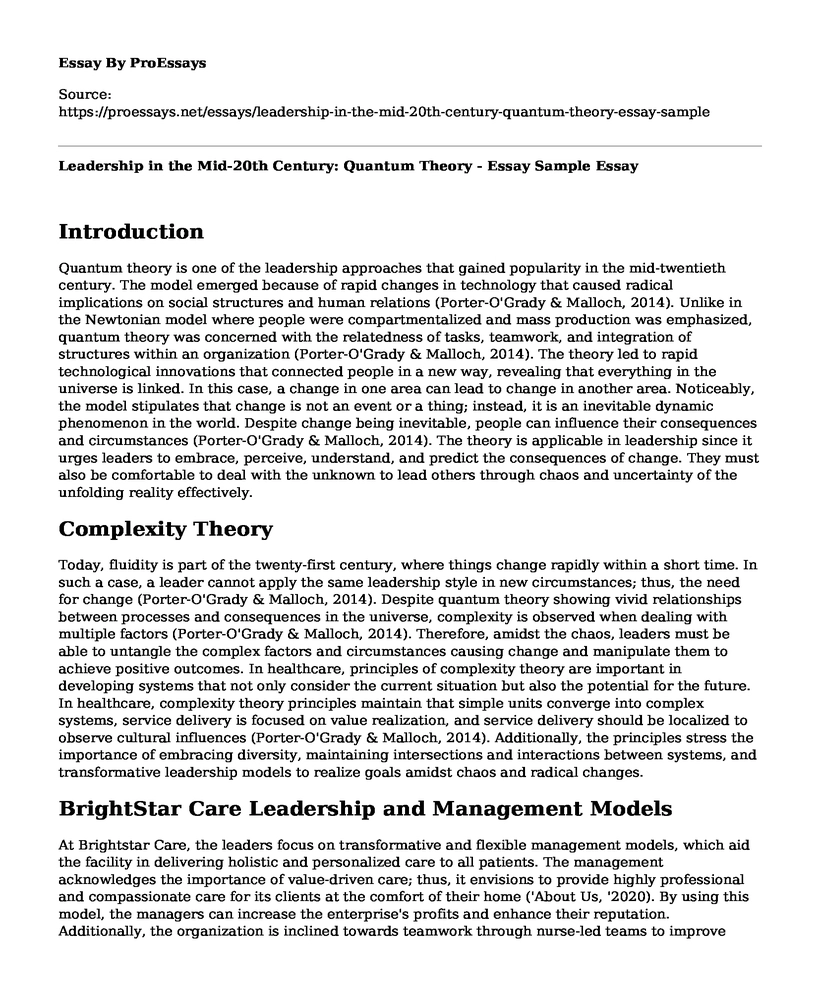Introduction
Quantum theory is one of the leadership approaches that gained popularity in the mid-twentieth century. The model emerged because of rapid changes in technology that caused radical implications on social structures and human relations (Porter-O'Grady & Malloch, 2014). Unlike in the Newtonian model where people were compartmentalized and mass production was emphasized, quantum theory was concerned with the relatedness of tasks, teamwork, and integration of structures within an organization (Porter-O'Grady & Malloch, 2014). The theory led to rapid technological innovations that connected people in a new way, revealing that everything in the universe is linked. In this case, a change in one area can lead to change in another area. Noticeably, the model stipulates that change is not an event or a thing; instead, it is an inevitable dynamic phenomenon in the world. Despite change being inevitable, people can influence their consequences and circumstances (Porter-O'Grady & Malloch, 2014). The theory is applicable in leadership since it urges leaders to embrace, perceive, understand, and predict the consequences of change. They must also be comfortable to deal with the unknown to lead others through chaos and uncertainty of the unfolding reality effectively.
Complexity Theory
Today, fluidity is part of the twenty-first century, where things change rapidly within a short time. In such a case, a leader cannot apply the same leadership style in new circumstances; thus, the need for change (Porter-O'Grady & Malloch, 2014). Despite quantum theory showing vivid relationships between processes and consequences in the universe, complexity is observed when dealing with multiple factors (Porter-O'Grady & Malloch, 2014). Therefore, amidst the chaos, leaders must be able to untangle the complex factors and circumstances causing change and manipulate them to achieve positive outcomes. In healthcare, principles of complexity theory are important in developing systems that not only consider the current situation but also the potential for the future. In healthcare, complexity theory principles maintain that simple units converge into complex systems, service delivery is focused on value realization, and service delivery should be localized to observe cultural influences (Porter-O'Grady & Malloch, 2014). Additionally, the principles stress the importance of embracing diversity, maintaining intersections and interactions between systems, and transformative leadership models to realize goals amidst chaos and radical changes.
BrightStar Care Leadership and Management Models
At Brightstar Care, the leaders focus on transformative and flexible management models, which aid the facility in delivering holistic and personalized care to all patients. The management acknowledges the importance of value-driven care; thus, it envisions to provide highly professional and compassionate care for its clients at the comfort of their home ('About Us, '2020). By using this model, the managers can increase the enterprise's profits and enhance their reputation. Additionally, the organization is inclined towards teamwork through nurse-led teams to improve home care outcomes. Teams led by registered nurse leaders provide additional support, care, and resources that surpass the routine medical needs ('About Us," 2020).
Moreover, Brightstar Care is mindful of its employees' career growth and development. As a result, it rewards the best performers in each department to motivate. Concerning quantum and complex management approaches, employee motivation is linked to improved service delivery (Porter-O'Grady & Malloch, 2014). Additionally, issuing incentives and rewards influences positive behavior and perceptions towards work (Griffin, Phillips, & Gully, 2020). The firm believes in more flexibility, which allows its leaders to adapt to change and realize success.
Recommendations
Nevertheless, the firm needs to focus more on diversity and organizational behavior. Today, cultural diversity is present everywhere and critical considerations should be put in place to ensure that organizational; behavior and service delivery meet the target population. Complexity theory principles stress the importance of embracing diversity and localizing care; therefore, Brightstar Care should ensure that its services are tailored to the community it serves.
On the other hand, a diverse workforce may be challenging to manage if an organization's leadership downplays factors such as race, ethnicity, religious beliefs, and individual perceptions (Griffin et al., 2020). The organization should train and promote diversity to create a healthy corporate culture, which motivates employees to test their potential. Moreover, leaders should influence the formation of interpersonal relationships among workers to create an ideal organizational culture.
References
About Us. (2020). BrightStar Care. Retrieved from https://www.brightstarcare.com/medical-staffing-solutions/positions-we-staff
Griffin, R. W., Phillips, J., & Gully, S. M. (2020). Organizational behavior: Managing People and Organizations (13th ed.). Boston, MA: Cengage. ISBN: 9780357042502
Porter-O'Grady, T., & Malloch, K. (2014). Quantum leadership, Sudbury, MA: Jones & Bartlett. ISBN-13: 9781284050684
Cite this page
Leadership in the Mid-20th Century: Quantum Theory - Essay Sample. (2023, Jul 06). Retrieved from https://proessays.net/essays/leadership-in-the-mid-20th-century-quantum-theory-essay-sample
If you are the original author of this essay and no longer wish to have it published on the ProEssays website, please click below to request its removal:
- The Uses and Significance of Quantum Mechanics in Nanotechnology - Paper Example
- Essay Sample on Atradius Organizational and Management Philosophy Adaptation
- Essay Example on Unleashing the Potential of Solar Energy: A History of Innovation
- Essay Example on Women in Evangelism and Faith-Based Leadership: A Theological Discourse
- Essay Sample on Drinking Reused Water: Boosting Natural Processes with Technology
- Annotated Bibliography Example on Schools Evolving: Adapting to the Changing Workplace Environment
- Paper Sample: Engagement in Professional Nursing







